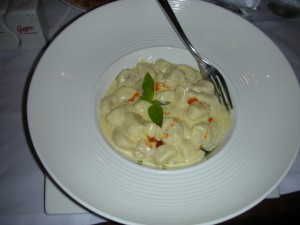 Grappa’s in Greenbelt 3 is my favourite Italian restaurant in Metro Manila.
Grappa’s in Greenbelt 3 is my favourite Italian restaurant in Metro Manila.
Grappa’s originated in Hong Kong, and now has a very attractive second home in Makati. It is spacious without that canteen quality, and the service is excellent: we always get an enthusiastic welcome from all the staff as if we were old friends. A small dish of olive oil and vinegar is immediately brought to the table with a choice of herb, tomato or plain freshly baked rolls. We happily dip and nibble as we choose from an extensive menu. The best spot for a quiet tête a tête is up on the balcony overlooking the park.
Before I go any further, I have a confession to make. To write a professional and properly objective restaurant review it is necessary to make a number of visits and sample a wide variety of dishes on the menu. And therein lies my problem – I have yet order anything but the gnocchi. Melt-in-the-mouth gnocchi with a sinfully creamy sauce laced with tomato oil and a surprising layer of pesto waiting beneath. For me, it is main course and dessert in one.
So instead of a restaurant review, here I am, to introduce you to the simple gnocchi, this delicacy of classic Italian cuisine.
Gnocchi (nyoh-kee) is often mispronounced, and there is also some debate over the origin of the word. The singular form of this noun is gnoccho, which means dumpling, but is also slang for dunce. Some also suggest the word is derived from the word nocchio (a knot in wood) or nocca (knuckle).
There were also many contradictory opinions when I started looking into the history of this simple dish.
Some say a semolina based gnocchi was introduced by the Romans, who spread the word across the Roman empire. Eventually each country went on to develop its own type of small dumplings, with the ancient Roman gnocchi as their common ancestor.
Others say it is more likely to have arrived with the Arabs when they invaded Sicily in the ninth century. The Arabs kept control for 200 years and significantly influenced the local cuisine by introducing North African and Middle Eastern flavours, most notably pasta.
Another thought is that gnocchi originated in mediaeval Lombardy, a dish devised for the pre-Lenten carnival celebrations that soon became a staple festival food. In Ravenna, it was the custom to serve gnocchi when celebrating the birth of a son.
Pasta means dough made of flour and water, so gnocchi is part of the pasta family. Before potatoes were introduced into Europe until the sixteenth century, gnocchi was made from semolina. This is coarse wheat bran used for making pasta, puddings and breakfast cereals.
Gnocchi can be made from a variety of ingredients. Apart from semoloina and the commonly known potato gnocchi, pumpkin, beetroot, maize or chestnut flour are also used. They may then be flavored with spinach, saffron, and even truffles. They are boiled in water or broth and, like pasta, they can be decorated with many sauces such as pesto, tomato, butter, and cheese. In some regions they even come sweet, stuffed with dried plums or plain chocolate.
Like many Italian dishes, there are a huge variety of shapes, sizes and ingredients across different regions, not to mention the rivalry for the best gnocchi!
The Tuscan malfatti, for example are gnocchi made from flour, ricotta, and chopped spinach (malfatti means badly made!) In Trentino, the gnocchi are smaller, made with spuds and beetroot, and sprinkled with poppy seeds. Semolina gnocchi from Rome is topped with cheese and baked, and the gnocchi gnudi (naked gnocchi) from Tuscany, is made with ricotta cheese and spinach. One dish popular in the north east is gnocchi di pane (literally ‘bread lumps’), made from breadcrumbs. Sardinia’s malloreddus look like small ribbed shells. They are seasoned with saffron and served with tomato sauce, spicy sausage and feta cheese.
Gnocchi is also a very popular dish on the Dalmatian coast of Croatia, where the Italians resided for generations. Here gnocchi is typically served as a first course or a side dish with beef stew. There is also a French dish known as gnocchis à la parisienne, in which the gnocchi are made from choux pastry and served with Bechamel sauce.
A dish of gnocchi is a particularly popular prima piatta (first course) in northern and central Italy, but it can be heavy, bland, rubbery lumps of dumpling if not made properly. So here are some tips:
A fellow blogger warns that making gnocchi is not for the faint-hearted, as so many things can go awry. At worst, gnocchi can become dense and soggy or just disintegrate in the boiling water. Making gnocchi apparently takes plenty of practice, patience and persistence.
When making gnocchi from potatoes, floury red potatoes are best, and the spuds must be as dry as possible or the gnocchi will be too stodgy. So bake them in their skins instead of boiling them. Beware of adding too much flour, or the gnocchi will become turgid and leaden.
Connoisseurs say that gnocchi should be soft and light: a plate of perfect potato pillows, best served au naturel with butter and parmesan. Others prefer accessorizing, and like a rich red sauce to go with it. Either way, each gnoccho should be grooved to better absorb the butter or sauce.
So, now my mouth is watering, how to find an excuse for a trip to Italy in May,when I hear there’s a 500 year old carnival in Verona celebrating the gnocchi…

Absolutely fascinating!
well, only if you like gnocchi!